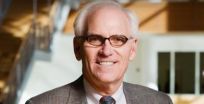(Press-News.org) Chemists at the University of California, San Diego, have identified how a protein that accumulates in the brains of people with Alzheimer's disease interferes with the ability of cells to get rid of debris. They also found a natural mechanism by which this protein, amyloid beta, itself may be discarded.
Plaques of amyloid are a hallmark of the ailment, but no one is sure exactly how they contribute to catastrophic loss of memory and cognition.
Scientists have begun to suspect that amyloid disables a structure called a proteasome, which chops up proteins that cells no longer need into pieces that can be reused or discarded. Proteins that have been tagged for destruction pile up in the brains of Alzheimer's patients.
"Basically the trash is put out to the curb, but no one is picking it up," said Jerry Yang, an associate professor of chemistry and biochemistry who led the research effort.
Yang and postdoc Xiaobei Zhao showed that amyloid actually doesn't harm the proteasome. Instead it interferes with the processing of other proteins by competing for access, they report in a forthcoming issue of the journal ACS Chemical Neuroscience.
They found that the proteasome breaks long chains of toxic amyloid into smaller, harmless pieces. And because the proteasome has a greater affinity for amyloid, other proteins build up undigested.
"The fact that the proteasome can hack up amyloid fairly efficiently gives us some insight as to how normal clearance mechanisms actually work," Yang said. "We all have amyloid peptides, and we all get rid of them as well. The proteasome is in every cell."
Scientists believe amyloid plays a central role in the development of Alzheimer's disease and that an imbalance between production and clearance of amyloid leads to build up and the formation of plaques. But they aren't certain how amyloid is normally broken down and removed from the brain.
"Relatively little attention has been paid to how you get rid of it," Yang said. "Minimally, this finding reveals a little bit more about what the amyloid is doing within the cell – how it's altering the function of this very important piece of machinery. If proteasomal dysfunction turns out to be a primary factor in Alzheimer's disease then this will be a key finding."
INFORMATION:
The Alzheimer's Association and the Alzheimer's Disease Research Center funded this work.
Harmful amyloid interferes with trash pickup for cells in Alzheimer's disease
Discovery reveals a natural mechanism for getting rid of excess amyloid
2010-09-08
ELSE PRESS RELEASES FROM THIS DATE:
Young, male, testosterone-fueled CEOs more likely to start or drop deals: UBC study
2010-09-08
Too much testosterone can be a deal breaker, according to Sauder School of Business researchers at the University of British Columbia. Their paper, to be published in the INFORMS journal Management Science on September 10, shows that young CEOs with more of the steroidal hormone in their system are more likely to initiate, scrap or resist mergers and acquisitions.
The study by Sauder Finance Professors Maurice Levi and Kai Li, and PhD student Feng Zhang, titled "Deal or No Deal: Hormones and the Mergers and Acquisitions Game," shows that testosterone – a hormone associated ...
Study examines turbine effects on Yukon River fish
2010-09-08
Fairbanks, Alaska—A University of Alaska Fairbanks fisheries scientist has teamed up with Alaska Power and Telephone to study how a new power-generating turbine affects fish in the Yukon River.
So far, the news looks good for the fish.
"In the brief testing that we have been able to accomplish, we have no indication that the turbine has killed or even injured any fish," said Andrew Seitz, project leader and assistant professor of fisheries.
Alaska Power and Telephone installed the in-stream turbine near Eagle, Alaska this summer. They are testing its effectiveness ...
Research on team loyalty yields new insight into 'die-hard' fandom
2010-09-08
CHAMPAIGN, Ill. – There's a reason why some sports fans are referred to as "die-hards" – even after they move away, their loyalty to their hometown team endures, according to research by two University of Illinois professors.
Scott Tainsky and Monika Stodolska, professors of recreation, sport and tourism, say new residents of a community maintain an attachment to their old team or former city as a way of asserting their identity after they move.
"People new to a city don't just adopt their new hometown's team as a way to acclimate themselves in a new community," Tainsky ...
No need to worrry about deflation -- yet, U. of I. economist says
2010-09-08
CHAMPAIGN, Ill. — A University of Illinois economist says consumers and investors concerned about the specter of deflation looming over an already bleak economic landscape should relax – for the time being, at least.
Although the consumer price index is near zero, J. Fred Giertz says we're unlikely to see a prolonged deflationary period like the slump Japan experienced during its "lost decade" of the 1990s.
"We're close to zero right now, but we're not below zero," said Giertz, an Institute of Government and Public Affairs economist who compiles a monthly barometer ...
Brown-led research divines structure for class of proteins
2010-09-08
PROVIDENCE, R.I. [Brown University] — Most proteins are shapely. But about one-third of them lack a definitive form, at least that scientists can readily observe. These intrinsically disordered proteins (IDPs) perform a host of important biological functions, from muscle contraction to other neuronal actions. Yet despite their importance, "We don't know much about them," said Wolfgang Peti, associate professor of medical science and chemistry. "No one really worried about them."
Now, Peti, joined by researchers at the University of Toronto and at Brookhaven National Laboratory ...
New compound safely reduces plaques in mouse model of Alzheimer's disease
2010-09-08
A new study identifies molecules that can be used to selectively reduce generation of the sticky, neuron-damaging plaques that are the hallmark of the Alzheimer's disease (AD) brain. The research, published by Cell Press in the September 9 issue of the journal Neuron, may lead to the development of effective and safe therapeutics for this currently incurable disease.
Previous research has suggested that an alteration in brain levels of amyloid ? proteins (A?) plays a major pathogenic role in AD, a devastating neurodegenerative disorder that causes progressive cognitive ...
Brain mechanism linked to relapse after cocaine withdrawal
2010-09-08
Addictive drugs are known to induce changes in the brain's reward circuits that may underlie drug craving and relapse after long periods of abstinence. Now, new research, published by Cell Press in the September 9 issue of the journal Neuron, uncovers a specific neural mechanism that may be linked to persistent drug-seeking behavior and could help to guide strategies for development of new therapies for cocaine addiction.
Previous research has shown that the ventral tegmental area (VTA) is a brain region that is activated when cocaine users experience a craving for cocaine ...
Single gene regulates motor neurons in spinal cord
2010-09-08
New York (September 8, 2010) – In a surprising and unexpected discovery, scientists at NYU Langone Medical Center have found that a single type of gene acts as a master organizer of motor neurons in the spinal cord. The finding, published in the September 9, 2010 issue of Neuron, could help scientists develop new treatments for diseases such as Lou Gehrig's disease or spinal cord injury.
The "master organizer" is a member of the Hox family of genes, best known for controlling the overall pattern of body development. By orchestrating a cascade of gene expression in ...
Compounds fend off Alzheimer's disease amyloid pathology
2010-09-08
A team of scientists, led by University of California, San Diego School of Medicine researchers, has synthesized hundreds of new compounds with the potential of reducing the production of the A-beta 42 peptide, a primary component of Alzheimer's disease (AD).
In mouse models, one tested compound specifically reduced levels of A-beta 42, which is believed to be responsible for the destruction of neurons, but left other essential enzymatic activities in the brain unaffected, said Steven Wagner, PhD, a project scientist in the UCSD Department of Neurosciences.
The ...
Extreme X-ray source supports new class of black hole
2010-09-08
A group of international astronomers in the UK, France and the USA, led by the University of Leicester, have found proof to confirm the distance and brightness of the most extreme ultra-luminous X-ray source, which may herald a new type of Black Hole.
The X-ray source, HLX-1, is the most extreme member of an extraordinary class of objects – the ultra-luminous X-ray sources – and is located in the galaxy ESO 243-49 at a distance of ~300 million light years from the Earth.
The astronomers' findings confirm that the extreme luminosity (which is a factor of ~100 above ...
LAST 30 PRESS RELEASES:
American College of Cardiology comments on new dietary guidelines for Americans
American Society of Gene & Cell Therapy and Orphan Therapeutics Accelerator partner to advance and commercialize promising rare disease treatments
One in 14 patients having day case surgery have new or worse chronic pain 3 months after their operation
New study highlights link between eviction rates and gun violence
Heatwaves heat up soil but not toxin levels in rice, study finds
Digital modeling reveals where construction carbon emissions really come from
Turning farm waste into water filters
New study shows how the spleen helps the immune system accept a transplant
New Mayo Clinic study advances personalized prostate cancer education with an EHR-integrated AI agent
Researchers identify novel therapeutic target to improve recovery after nerve injury
Microbes in breast milk help populate infant gut microbiomes
Reprogramming immunity to rewrite the story of Type 1 diabetes
New tool narrows the search for ideal material structures
Artificial saliva containing sugarcane protein helps protect the teeth of patients with head and neck cancer
Understanding the role of linear ubiquitination in T-tubule biogenesis
Researchers identify urban atmosphere as primary reservoir of microplastics
World’s oldest arrow poison – 60,000-year-old traces reveal early advanced hunting techniques
Bristol scientists discover early sponges were soft
New study uncovers how rice viruses manipulate plant defenses to protect insect vectors
NSF–DOE Vera C. Rubin Observatory spots record-breaking asteroid in pre-survey observations
Ribosomal engineering creates “super-probiotic” bacteria
This self-powered eye tracker harnesses energy from blinking and is as comfortable as everyday glasses
Adverse prenatal exposures linked to higher rates of mental health issues, brain changes in adolescents
Restoring mitochondria shows promise for treating chronic nerve pain
Nature study identifies a molecular switch that controls transitions between single-celled and multicellular forms
USU chemists' CRISPR discovery could lead to single diagnostic test for COVID, flu, RSV
Early hominins from Morocco reveal an African lineage near the root of Homo sapiens
Small chimps, big risks: What chimps show us about our own behavior
We finally know how the most common types of planets are created
Thirty-year risk of cardiovascular disease among healthy women according to clinical thresholds of lipoprotein(a)
[Press-News.org] Harmful amyloid interferes with trash pickup for cells in Alzheimer's diseaseDiscovery reveals a natural mechanism for getting rid of excess amyloid





